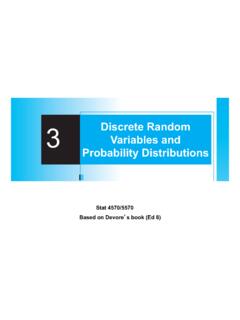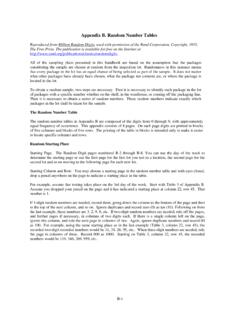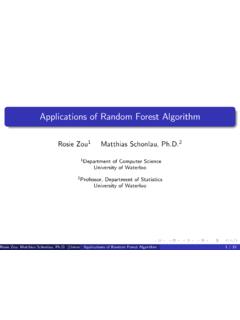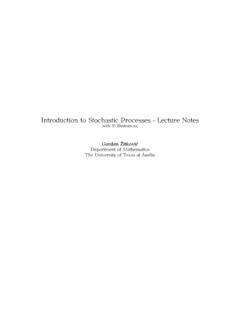Transcription of UNIT I: RANDOM VARIABLES PART- A -TWO MARKS 2. A ...
1 UNIT I: RANDOM VARIABLES . PART- A -TWO MARKS . 1. Given the probability density function of a continuous RANDOM variable X as follows f(x) = 6x (1-x) 0<x<1 . Find cumulative density function. x x x CDF F(x) = f(x) dx = 6x (1-x) dx = 6(x /2 x /3) = 3x2 2 x3 ,0 < x < 1. 2 3. 0 0 0. 2. A continuous RANDOM variable X can assume any value between x = 2 and x = 5 has a density function given by f(x) = k(x + 1). Find P(X < 4). 5 5 5. 2. f(x) dx = 1 k(x + 1) dx = k( x /2 + x) k(27/2) = 1 k = 2/27. 2 2 2. 4 4 4 4. 2. P(X < 4) = f(x) dx = k(x + 1)dx = 2/27 (x+1) dx = 2/27 (x /2 + x ) = 16/27.
2 2 2 2 2. 3. If moment generating function M X (t) = 1/3 et + 4/15 e3t + 2/15 e4t + 4/15 e5t . Find the probability mass function of X. X 1 2 3 4 5. P(X = x) 1/3 0 4/15 2/15 4/15. 4. Suppose MX(t) = ( e t + ) 8 . Find the MGF of Y = 3X + 2. M Y (t) = e 2t M X (3t) = e 2t ( e 3t + ) 8. 5. Define MGF. Why it is called so? MFG is defined as M X (t) = E ( e tx ) , which generates the moments of the RANDOM variable X, so it is called as Moment Generating function. 6. For a binomial distribution mean is 6 and standard deviation is 2. Find the first two terms of the distribution.
3 For a binomial distribution, Mean= np = 6. = npq = 2, npq=2. 6 X q =2, q= 1/3. P=. 1-q = 1- 1/3 = 2/3. n = 9. P(X=x) = nCx px q n-x, x = 0, 1, 2, ..,n P(X=0) = 9C0 (2/3)0 (1/3)9 = P(X=1) = 9C1 (2/3) (1/3)8 = 7. Comment of the following. The mean of a binomial distribution is 3 and variance is 4 For a binomialDistribution, variance. Soln: np = 3, npq = 4, (3) q=. 4, q = (4/3). It is not possible. The given statement is wrong. 8. Find p for a binomial variate, if n=6 and 9 P(X- 4) = P(X =2). Soln: P(X=x) = 6Cx px q 6-x, 9P(X = 4) = P(X = 2), 9 X 6C4 p4 q2 = 6C2 p2 q4. 9 p2 = q2, 9 p2 (1-p)2, Since q= 1- p.
4 9p2 = 1 + p2 2p 8p2 + 2p -1 =0, [ p+ (1/2)] [ p (1/4)] =0, P = . 9. State the conditions under which the Poisson distribution is a limiting case of the Binomial Distribution. Soln: ( i ) n, the number of trials infinitely large, n (ii) p, the prob. Of success infinitely small, p 0 (iii) np = , a constant. 10. In a book of 520 pages, 390 typo- graphical errors occur. Assuming Poisson law for the number of errors per page, find the prob. That a RANDOM sample of 5 pages will certain no error. Soln: = 390 / 320 = , P(X= x) = e- x / x!, x= 0, 1, 2, .. = ( )x / x! Required prob.
5 = ( P[X = 0] )2, = (e )2, = e X is the number of occurrences of the Poisson variate with mean , show that P[ X n] P[ X n+1] = P[ X n]. Soln: P[ X n] P[ X n+1] = 1 - P[ X < n] ( 1 P[ X < n+1]). = - P[ X < n] +P[ X< n+1]. n n-1. = { e- x / x! } - { e- x / x! }. x= 0 x= 0. - n = e / n! = P[ X=n]. 12. If X is poisson variate such that P[X=2] = (2/3) P[X = 1] evaluate P[X=3]. e- 2 / 2! = (2/3) {e- / 1! }. = 4 / 3. P[X=3] = e-(4/3) (4/3)3 / 3! 13. If for a Poisson variate X, E(X2) = 6 what is E(X). E(X2) = 2 + , Since Poisson distribution 2 = 2 + . Given E(X2) = 6, 2 + = 6.
6 2 + - 6 = 0. = 2, -3. But >0, =2. Therefore E(X) = 2. 14. If X is a Poisson variate with mean , Show that E(X2) = E(X+1). W. K. T. For a Poisson variate E(X2) = 2 + . Now E(X+1) = E(X) +E(1) = E(X) + 1. = +1. Now E(X2) = 2 + . = ( +1) E(X2). = E(X+1). 15. determine the distribution whose is MX ( t ) = e3( e t 1 ). Also Find P(X=1). of a poisson distribution MX ( t ) = e ( e t 1 ). Given MX ( t ) = e3( e t 1 ). = 3. P(X= x) = e- x / x!, x =0, 1, 2, .. P(X= x) = e-3 3x / x!, x =0, 1, 2, .. P(X=. 1) = e-3 3 / 1!, x =0, 1, 2, .. = 3e-3. 16. Find the of geometric distribution.
7 MX ( t ) = E ( e tx ).. = e tx. P(X=x). x= 0.. = e tx. p qx x= 0.. = p (e t q)x. x= 0. = p [ 1 q et ] -1. = p / ( 1- q et). 17. Identify the distribution with MGF MX(t) = ( 5 4 et ) -1. MX ( t ) = { (1/5) / [1- (4/5)et ] }. WKT, MGF of Geometric distribution, MX(t)= p / ( 1- q et ). The Given MGF is the MGF of geometric distribution with parameter. P= 1 / 5, q = 4/5. P[X= x] = (1/5) (4/5) x-1, x= 1, 2, . 18. determine the distribution whose MGF is MX (t) = (1/3) et [e- t (2/3)]-1. Soln: The MX (t) of negative binomial distribution with parameters p and r is MX (t) = pr [ 1 q et] r, Given MX (t) = (1/3) [ e t e t (2/3) e t] 1, = (1/3) [1 (2/3) e t] 1, This is the of Negative Binomial Distribution with parameters r = 1 and p = 1/3.
8 19. Find the MGF of a uniform distribution in (a, b). b MX (t) = [1 / (b-a)] = etx dx. a b = [1 / (b-a)] {etx / t} = [ebt - eat] / (b-a)t a 20. Find the MGF of a which is uniformly distributed over (-1, 2). Soln: 2. MX (t) = [1 /3] = etx dx. = [(e2t e-t) / 3t], t 0. -1. 2. MX (t) = [1 /3] = dx. =1, for t 0. -1. 21. If X has uniform distribution in (-3, 3) find P[ |X - 2| < 2]. is f(x) = 1/6, -3< X < 3. P[|X - 2| <2 ] = P [ 0< X < 4]. 3. =(1 / 6) dx = 1 / 2. 0. 22. State the additive property of Gamma distribution. If X1, X2, . Xn are independent Gamma variates with parameters 1, 2, 3, n respectively, then X1 + X2 +.
9 + Xn is also a Gamma variate with parameter 1+ 2 + 3+ + n. 23. Mention any four properties of normal distribution. (1) The curve is bell shaped (2) Mean, median, mode coincide (3) All odd central moments vanish (4) X axis is an asymptote toe the normal curve. 24. If for a normal distribution, the first moment about 10 is 40 and the fourth moment about 50 is 48. Find the mean and of the distribution. Mean = A+ '1. Mean = 10 + 40 = 50. 4' (about the point X = 50) = 48. Since mean is 50, 3 2 = 4. '. 3 2 = 48 ; = 2. 25. X is a normal variate with mean 1 and variance 4, Y is another normal variate independent of X with mean 2 and variance 3, what is the distribution of X+2Y= ?
10 E[ X+2Y] = E[X] + 2E[Y] = 1 + 4 = 5. V[ X+2Y] = V[X] + 4V[Y] = 4 + 4(3) = 16. X + 2 Y is a normal distribution with parameter 5, 16. 26. If the continuous X has f(x)= 2(x+1) / 9, -1 < X < 2. Find the of Y =. X2. fY (y) = 2 / [9 y], 0< y < 1. fY (y) = 1 / a[1 + (1/ y) ], 1< y < 4. 27. If X is uniformly distributed in (-1, 1). Find the of y = sin [ x / 2]. fX (x) = 1 / 2, -1< x < 1. dy /dx = cos [ x/2] . /2. dx / dy = 2 / [ 1- y2] , -1 y 1. fY (y) = 2 / [ 1- y2], -1< y < 1. 28. If X has negative binomial distribution with parameters (n,p). Prove that MX(t) is ( Q P et ) -n n Pe.








